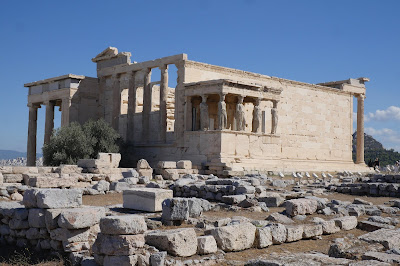The Acropolis seen from the Agora
We arrived in Athens last night and our first major piece of tourism was to visit the Acropolis. I have headed this post "The Acropolis of Athens" because it turns out that there are numerous acropolises in Greece - the term means the highest point of a city, a citadel. Athens of course is home to The Acropolis.
We soon realised that because Athens is quite a low-rise city, it is completely dominated by the Acropolis which is visible from almost anywhere. The best view seems to be from the Agora however.
From the coach park you walk uphill through an olive grove ...
... and enter the Acropolis via the Beulé Gate. Immediately on the right is the Odeon of Herodes Atticus, which dates from 161 AD; that is, when Greece was under the Roman Empire.. It was destroyed by barbarians (in this case the Heruli) in 267 AD and restored in 1950. It is still used for music concerts.
Further up you reach the entrance to the Acropolis, the Propylaea (the work of the architect Mnesikles, and built 437-32 BC). It is a pinch point and very congested. It is quite hard to make sense of all the columns.
Immediately on the right as you enter is the exquisite temple of Athena Nike (nike means Victory). It was designed by the architect of the Parthenon, Kallikrates, completed in 420 BC and built in Pentelic marble. There are only four columns at each end (and none on the sides) and unusually they are monolithic, that is they are each made of a single block of stone instead of the usual horizontal drums. There is a rather beautiful frieze below the triangular pediment.
Turning away from the Temple of Athena Nike, you are confronted by the massive Parthenon. It was built in only 15 years between 447 BC and 432 BC and is often described as the most perfect Doric temple ever built. Nowadays, it is still undergoing a process of restoration and has a great deal of scaffolding around it. There is an enormous amount of stone scattered all around, some with beautiful carving.
It gradually became clear that the best strategy would be to walk around to the south (?) and see it from the rear. This offers a much more coherent view and the scaffolding is obscured.
... and the Parthenon Museum (of which more later).
You can also see the Roman Forum with the wonderful Temple of Hephaestus in the top left. We plan to visit this tomorrow.
The final great building on the Acopolis is the Erechtheion, completed in 406 BC. It was built as a sanctuary for the cults of all the deities ever worshipped in Athens, which explains its odd shape.
Its greatest feature is the caryatids who hold up the roof - a caryatid is a column sculpted in the form of a woman or girl. (We felt a special affinity with these having enjoyed St Pancras church (1822) in Euston Road in London which has a very similar set, undoubtedly inspired by these.)
We dragged ourselves away from the Acropolis and walked down to the Museum. It is aligned spatially with the Parthenon and inside it has the same number of (steel) columns with the same spacing as in the Parthenon. It is a truly visionary concept. On the top floor the metopes (carved stone panels) are arranged in their original order (having been removed from the Parthenon itself to prevent further deterioration and cleaned up).
Many of these metopes contain sculpture of the highest order and being at a modest height above the floor they are much easier to really appreciate than when they were high up on the temple's exterior.
Finally, on the second floor, we saw the original caryatids from the Erechtheion. They too have been removed for their protection and replaced with replicas.
Conditions: hot and sunny.
Rating: five stars. Truly wonderful!













No comments:
Post a Comment